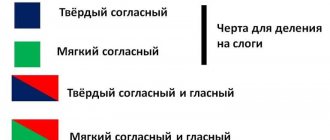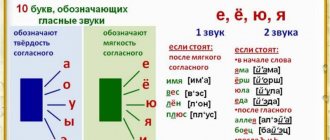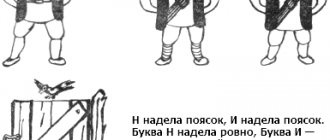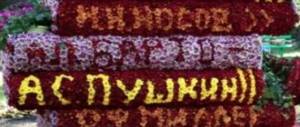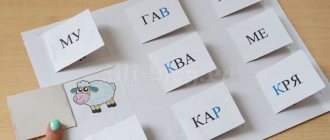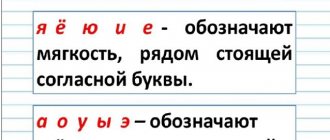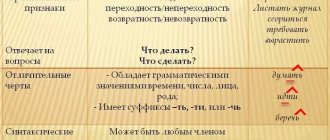Is it a word or a sentence?
The diagram is a graphic model that, using symbols, displays the components of the whole and their interrelationships. From the first days of school, children learn that sentences are made up of words, words are made up of syllables, and syllables are made up of sounds. Diagrams of words and sentences help to see this clearly.
However, these concepts are often mixed up in a child’s head. First-graders get confused in the symbols, drawing lines instead of colored squares. Explain to the child that a word is the name of a separate object, action, or characteristic. A sentence consists of several words connected to each other and conveys a complete thought.
Let the first grader determine whether he hears individual words or a sentence. Thus, the phrase “The crow is sitting on the fence” would be a sentence. Draw a diagram for it. If you say “crow, sit, fence”, then we are faced with just a set of words unrelated to each other. There is no need to draw a proposal diagram.
so UNT / Lesson plans for the Russian language / Lesson plans for teaching literacy 1st grade Atamur
Certificate 1st grade. Topic: Sound-syllable analysis of a word: identification of syllables in a word, characteristics of sounds. Pronunciation of tongue twisters.
28.09.2014 3720 0
Goals:
1) systematize knowledge about sounds and letters; develop the ability to create sound patterns and sound models of words;
2) development of phonemic hearing; speech development; development of thinking and imagination; enrichment of the emotional world;
3) fostering a culture of communication in pairs and in the classroom.
During the classes.
1.Organizational moment
2. Communicating the purpose and topic of the lesson
3.Repetition
-Tongue Twisters
- Mom did not spare soap. Mom washed Mila with soap. Mila didn't like soap, Mila dropped the soap.
· Cuckoo bought a hood. How funny he is in the hood.
· Eagle on the mountain, feather on the eagle. A mountain under an eagle, an eagle under a feather.
What are the sounds of speech? ( Vowels and consonants)
—
How do we pronounce vowel sounds? (
Freely, without barriers, mouth wide open)
- How do we designate vowel sounds on the diagram?
— How do we pronounce consonants? (With obstruction from the speech organs: lips, teeth, tongue)
—
How do we denote consonant sounds in the diagram?
Two people working at the board draw up a sentence diagram (Autumn has come, My sister’s name is Nastya)
Examination.
4.Work on the topic of the lesson
-We characterize vowels and consonants, remembering always soft, always hard consonants.
-Work in pre-letter books, we parse words, do sound-syllable analysis
5. Physical training
6. Fastening
Game » Say the sound » Purpose: to teach how to identify the last sound in a word based on presentation.
Progress of the game: The teacher pronounces a sentence without finishing the last sound in the last word, and throws the ball to any player. What sound did I miss? A ferret, a predatory little animal, walks through the forest... Your voice is so good, you sing very sweetly... A couch potato, a red cat, laying down briskly...
Game » Find the escaped sound » Goal: identifying the first sound in the words of your own speech. Progress of the game: The teacher reads poems that contain words with the first sound missing. Children must guess which word has a missing sound, pronounce this word, and then highlight and name the “missing sound.” A point is given for each correct sound. > Looks ..sun through the window, In this river early in the morning Shines into our little room, Two ..arans drowned. We clapped our hands. Who alone has a horn? Very happy...sun. Well, of course...a wasp!
- What sound is missing?
Finger gymnastics
Writing learned elements of lowercase and uppercase letters
-We analyze, write in the air, pronounce the spelling of elements
7. Lesson summary
—
What did they talk about in class today?
— where did the difficulties arise?
Reflection
Syllable and stress
Having figured out the difference between a word and a sentence, you can move on to drawing up syllable patterns. Please note that there are different conventions in textbooks. Most often, a word is represented by a line or a rectangle, which is divided by vertical lines into the required number of syllables. The accent is indicated by a short oblique stick on top. In 1st grade, work on the sound composition begins with similar word schemes.
Students of philological universities are not always able to explain the division of words into syllables in the Russian language. The easiest way is to imagine that you are communicating with a person on the other side of the river. Shout the word loudly and drawn out. Sounds pronounced in one exhalation make up a syllable. The emphasis can be determined by placing your fists one on top of the other and placing your chin on top, but not tightly. When pronouncing a stressed syllable, the pressure of the jaw on the hands will be the strongest.
Vowels
One of the most important parts of our spoken language is the presence of vowels. They are so named based on their main function - to transmit long-lasting sound with the voice. There are six of them in Russian: A, O, U, Y, I, E.
It must be remembered that the number of letters does not always coincide with the number of sounds. For example, the word “south” has 2 letters, but at the same time 3 sounds: “yuk”. A letter-sound analysis of a word should show what is different from the way we write.
Vowels make up syllables in words. It is by their number that they determine how many parts the word is divided into:
- pal-ka
- there are 2 syllables because it has two vowels; - som -
1 syllable, since there is one vowel.
In addition, you need to know the features of letters such as e, ё, yu, ya. They, unlike all the others, can form two sounds - a vowel in combination with Y:
- Yo (y+o);
- E (y+e);
- Yu (y+y);
- I (y+a).
This phenomenon is observed in cases where the listed sounds are used:
- after soft or hard signs ( pouring, zealous
); - after a vowel ( bigYa, poyas
); - at the beginning of the word ( Yula, El
).
Very often, when performing a sound analysis of a word (the diagram is given below), children make mistakes precisely in parsing these vowels.
All the other characteristics that vowels have are quite simple. Especially those that are studied in the school curriculum. Only two signs are considered: stress or unstress.
Sound patterns of words
Children have the most problems at this stage. Meanwhile, it is the sound patterns of words that help children realize that spelling and pronunciation often do not coincide with each other. It is better to start training with simple words, gradually complicating the task. The first step is to divide the word into syllables.
The second stage is determining the quantity and quality of sounds. At first, use the hint sign. On it, as in the diagram, vowels are marked in red. Sounds from the top row are placed after hard consonants, from the bottom - after soft ones. The letters i, e, yu, e designate two sounds (й+а, й+о, й+у, й+е), if they are at the very beginning of words, after another vowel, and also after the “silent” letters ъ, ь .
Consonants can be hard (marked in blue on the diagram) or soft (colored in green pencil). When drawing a diagram, we analyze each syllable in turn. We represent a single sound as a square of the corresponding color. The fusion of a consonant with a vowel is a rectangle divided in half by a diagonal line. The lower part represents a consonant, the upper part represents a vowel. After drawing the diagram, add stress and separate the syllables with a vertical line.
Memo for a first grader “How to make a word diagram”
Dear parents.
This reminder will help you and your child learn how to quickly and correctly create word patterns.
FIRST-GRADER MEMO “How to make a word diagram”
Make a diagram of the word - ASPHALT
1.
Repeat this word several times, listen to what SOUND (not letter) it begins with.
The word ASPHALT begins with the sound A.
2.
We repeat this sound several times and find out whether it is a vowel or a consonant (vowels “stretch, sing”, consonants “break off”).
When pronounced, the sound A is drawn out and sung, which means it is a vowel.
3. ALWAYS, if there is a vowel sound at the beginning of a word, it is indicated by a red square.
Draw a red square.
4.
Repeat the entire word again, emphasizing the next sound with your voice.
The next sound is S.
5.
We repeat this sound several times and find out whether it is a vowel or a consonant (vowels “stretch, sing”, consonants “break off”).
The sound C is a consonant.
6.
Find out what sound follows it: a vowel or a consonant (if it is a vowel, then the consonant and vowel will merge).
To do this, you should say the whole word again and listen - what sound comes after the sound C? After the sound C there is a consonant sound F. This means there is no consonant-vowel merger. Therefore, we denote the sound C with a square.
7.
Let’s find out what color we will use to denote the square with the sound S on the diagram. To do this, say the word again and listen to how the sound S sounds in the word: hard or soft?
The sound C sounds hard, so we will color the square blue.
8.
We repeat the whole word again, emphasizing the next sound with our voice.
The next sound is F.
9.
We repeat this sound several times and find out whether it is a vowel or a consonant (vowels “stretch, sing”, consonants “break off”).
The sound F is a consonant.
10.
Find out what sound follows it: a vowel or a consonant (if it is a vowel, then the consonant and vowel will merge).
To do this, you should say the whole word again and listen - what sound comes after the sound F? After the sound F there is a vowel sound A. This means that a consonant-vowel merger has occurred. Therefore, we denote both sounds F and A by triangles in the diagram.
11.
Find out what color the triangles will be.
To do this, let’s say the word again and listen to how the sound F sounds in the word: hard or soft? The sound F sounds hard, so we will color the triangle blue, and the sound A is generally a vowel, it is always red.
12. We repeat the whole word again, emphasizing the next sound with our voice.
The next sound is L
,
.
It is soft because the letter soft sign - ь, which does not indicate any sound, gives it softness
. So we will color it green.
13.
Find out what sound follows it: a vowel or a consonant (if it is a vowel, then the consonant and vowel will merge). To do this, you should say the whole word again and listen to what sound comes after the sound L , .
After the sound L
,
there is a consonant sound T. This means there is no consonant-vowel merger. Therefore, we draw a green square.
14. We repeat the whole word again, emphasizing the next sound with our voice.
The next sound is T. It sounds hard.
So we will paint it blue. There is no vowel after it, which means there is no merger.
Therefore, we draw a blue square.
15. Let's divide the word into syllables.
To do this, let’s pronounce the word slowly and find out how many times we stopped while pronouncing the word.
AS FALT stopped once, which means two syllables. We must remember: there must always be one vowel sound in a syllable!
Let's divide the diagram into syllables.
16.
Let's put emphasis.
To do this, we say the word quickly and loudly. Let's listen to what sound we pronounced the loudest, what sound we stayed on for the longest time. In the word ASPHALT, the second sound A sounded louder and longer than others. He turned out to be a striker. This means that in the diagram of the word, above the triangle that belongs to the second sound A, you need to put a line - stress.
Rules - tips
· The letters
a, o, u, s, e, o give hardness to the preceding consonant.
· The letters
i, e, ё, yu, i add softness to the preceding consonant.
If it is difficult for a child to determine by ear the hardness or softness of a consonant, then these letters will help with this.
· Some vowel letters, when placed at the beginning of a word, or after a vowel, or after a soft sign, denote two sounds.
E – th, e; Yo - th, o; Yu - th, y; I - th, a.
For example: fir-tree, ё is at the beginning, which means it means two sounds ё-лка.
And when drawing up diagrams, you need to draw in place of such letters the merger CONSONANT - VOWEL YO, YA, YU, YE. Moreover, the sound Y is always soft, which means we will color it in green, and the next sound is always a vowel, which means we will color it in red.
Scheme of the word SING (Ё is after a vowel, which means it will mean two sounds Y O)
Composition of the word
Morphemic analysis of words is usually studied in 2nd grade, although some programs introduce it to first graders. The ability to find a root, prefix and other significant parts is very important for developing competent writing skills. Children draw new word patterns and remember generally accepted symbols.
This is not easy for all students. Learn a simple algorithm with your child:
- Write the word.
- Decline it according to cases or conjugate it according to persons and numbers. The ending letters changing at the same time will be the ending. The rest of the word is the stem. Sometimes there is a null ending.
- Choose as many related words as possible. Their common part is called the root.
- The letters in front of it are a prefix.
- There can be a suffix between the root and the ending. Or several suffixes, as in the word “teacher”.
- Graphically highlight all the parts in the word, redraw their symbols below or next to them. The result is a diagram.
Learning to think
Most often, schoolchildren's mistakes are associated with a formal approach. The lexical meaning of the word is not taken into account. Children try to find already familiar suffixes in the word (-chik- in the lexemes “ball”, “ray”), prefixes (-u- in the adjectives “morning”, “narrow”). To avoid this, children are taught to select words to match the indicated patterns. You can create such tasks yourself.
Draw a diagram of the word: root + suffix + ending. Which of the lexemes listed above are suitable for it: racer, raincoat, storekeeper, cartiler? Which words have a zero ending, a prefix and a root: raid, tune, burbot?
Drawing up a word diagram is quite a difficult task for a primary school student. In order not to discourage your interest in studying with boring workouts, turn them into a game. Conduct lessons for dolls, organize competitions with prizes, and for correct answers, give a part of the picture that will need to be assembled in the end. Put in a little effort and it will definitely be rewarded.
